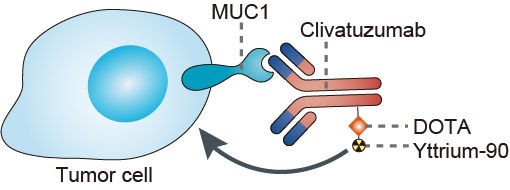Yttrium (90 Y) Clivatuzumab Tetraxetan Overview
Introduction of Yttrium (90 Y) Clivatuzumab Tetraxetan
Yttrium (90 Y) Clivatuzumab Tetraxetan (trade name hPAM4-Cide) is a humanized monoclonal antibody-drug conjugate (ADC) designed by Immunomedics, Inc. for the treatment of pancreatic cancer. The antibody part, clivatuzumab (also known as PAM4), which targets mucin 1 (MUC1), is conjugated with the chelating agent 1,4,7,10-tetraazacyclododecane-N,N’,N’’,N’’’-tetraacetic acid (DOTA), tetraxetan, and radiolabeled with the beta-emitting radioisotope Yttrium-90, a radioisotope which destroys the tumor cells. PAM4 is an lgG1 monoclonal antibody (mAb) produced by immunization of mice with mucin purified from the xenografted RIPI human pancreatic cancer-originally a mucinous, moderately differentiated tumor in the head of the pancreas. MUC1 is a transmembrane glycoprotein associated with cell transformation, invasion, migration, apoptosis, cellular interactions, immune regulation, and drug resistance. PAM4 recognizes a unique and novel epitope which is not reactive with the peptide core of mucin and distinct from that of B72.3, CA19-9, DUPAN2, Span1, Nd2, CEA, and Lewis antigens. The PAM4 epitope is a conformationally dependent peptide epitope. Furthermore, the PAM4 epitope was found to be highly sensitive to heat, reduction of disulfide bonds, proteolytic digestion, or deglycosylation. In addition, the epitope was partially sensitive to periodate oxidation or neuraminidase digestion. Although the detailed characteristic of the PAM4 epitope is unknown, it is thought to be dependent on MUC1 glycosylation status. DOTA (also known as tetraxetan) is an organic compound which can be conjugated to mAbs by attachment of one of the four carboxyl groups as an amide. The remaining three carboxylate anions are available for binding to the yttrium ion. The modified antibody accumulates in the tumor cells, concentrating the effects of the radioactivity of yttrium-90.
Mechanism of Action of Yttrium (90 Y) Clivatuzumab Tetraxetan
MUC1 is normally expressed in the glandular or luminal epithelial cells of the mammary gland, esophagus, stomach, duodenum, pancreas, uterus, prostate, and lungs, and to a lesser extent, in hematopoietic cells. MUC1 serves a protective function by binding to pathogens and also functions in a cell signaling capacity. In the cell nucleus, the protein MUC1 regulates the activity of transcription factor complexes that have a documented role in tumor-induced changes of host immunity. Overexpression, aberrant intracellular localization, and changes in glycosylation of this protein have been associated with carcinomas. Aberrantly glycosylated MUC1 is overexpressed in most human epithelial cancers and has gained remarkable attention as an oncogenic molecule. Tumor-associated MUC1 (TA-MUC1) differs from that expressed in normal cells, both in its biochemical features and its cellular distribution. Clivatuzumab binds to the extracellular domain of the MUC1 tumor antigen, delivering a cytotoxic dose of beta radiation, which helps to kill the tumor cells. While clivatuzumab is utilized to deliver radiation to the cell, it also retains its properties of ADCC, which may result in the inhibition of MUC1-mediated signaling pathways.
 Fig.1 Mechanism of Action of Yttrium (90 Y) Clivatuzumab Tetraxetan
Fig.1 Mechanism of Action of Yttrium (90 Y) Clivatuzumab Tetraxetan
For research use only. Not intended for any clinical use.
This site is protected by reCAPTCHA and the Google Privacy Policy and Terms of Service apply.



